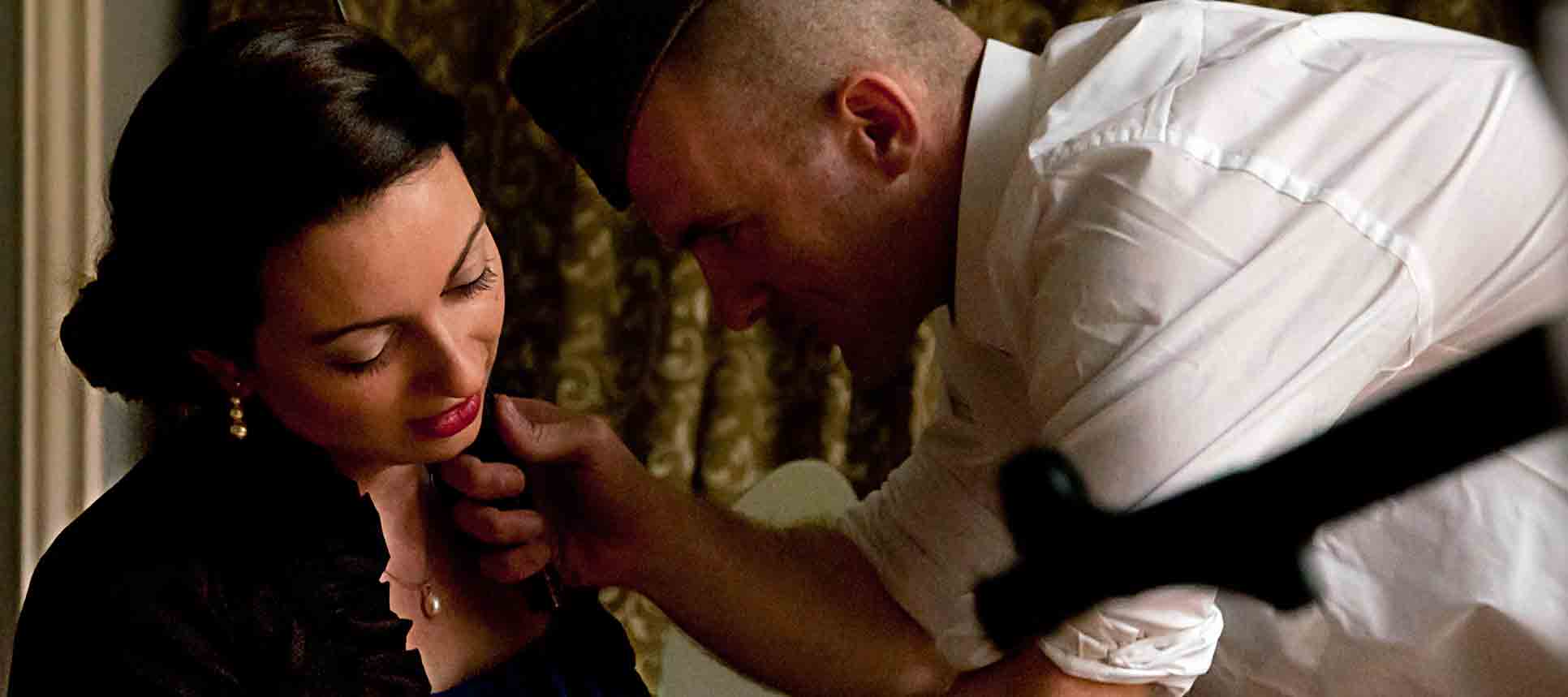 The theme of alternate sexuality, identity, and freedom juxtaposed with the tragedy of death permeates Just a Little Lovin’. Photo by Elina Andersson. CC-BY-NC.
The theme of alternate sexuality, identity, and freedom juxtaposed with the tragedy of death permeates Just a Little Lovin’. Photo by Elina Andersson. CC-BY-NC.Just a Little Lovin’ is commonly touted as one of the best Nordic larps ever designed by those who have played it. Originally written in 2011 by Tor Kjetil Edland and Hanne Grasmo, the larp explores the lives of people in alternative sexual and spiritual subcultures during the span of 1982-1984 in New York who attend the same 4th of July party each year. As the larp progresses, the AIDS crisis increasingly sweeps through their community, affecting each member directly or indirectly. The result is a cathartic explosion of emotions that leave a lasting impact on the majority of the players.
This article will discuss some of these rhetorical threads surrounding the design of Just a Little Lovin’. Then, I will emphasize the importance of the ritual spaces and structures within the larp, which work to enhance communal connection in- and out-of-game and help produce these strong moments of catharsis.
Player Discourse Surrounding Just a Little Lovin’
Oh no, not I! I will survive!
Oh, as long as I know how to love, I know I’ll stay alive!
I’ve got all my life to live.
I’ve got all my love to give.
And I’ll survive! I will survive!
 Most characters came together each year in a ritualized fashion for the drag/variety show. Here, they enjoy a performance by the rock band Urban Renaissance. Photo: Petter Karlsson. CC-BY-NC.
Most characters came together each year in a ritualized fashion for the drag/variety show. Here, they enjoy a performance by the rock band Urban Renaissance. Photo: Petter Karlsson. CC-BY-NC.In play reports, participants mention several powerful elements of the design. The characters have realistic motivations and relationship dynamics. The intersecting themes of desire, love, friendship, and fear of death interweave beautifully throughout the larp to provide a roller coaster of emotions for the players. The mechanics for sex and death are thoughtfully implemented, providing a meaningful, relatively safe framework in which to experience these powerful moments. The larp is organized into three Acts, with careful workshopping and debriefing exercises framing each phase. These breaks allow players opportunities to co-create the experience with one another through negotiation and agreement. While the larp does deal with the tragedy of disease impacting a tightly knit community of creative, experimental, open-minded people, the emphasis of the larp is not to dwell in tragedy, but rather to undergo a strengthening of that community through shared experience.
 A lesbian contingent with their dutch boy. Participants emphasize an intensified sense of community after the larp in their play accounts. Photo: Petter Karlsson. CC-BY-NC.
A lesbian contingent with their dutch boy. Participants emphasize an intensified sense of community after the larp in their play accounts. Photo: Petter Karlsson. CC-BY-NC.As UK larper Mo Holkar recently wrote regarding the fourth run of the larp in Denmark 2015:
I have never had my mind opened more by a larp, nor felt more bonded to a group of co-players – including those who I didn’t actually interact with during play. And, importantly, this is not because we came through a terrible experience together: it wasn’t like that at all. It’s because we came through an amazing and uplifting and life-affirming and worldview-changing experience together.
Similar accounts exist in articles by other former players:
I’ve got this sense that I’ve stolen a true glimpse of the past, or at least a past that could have been. We’ve created something real, and beautiful, and momentous. I don’t know how to handle that. It’s immense pride and I already feel nostalgic for it. In the most literal sense — I’m starting to feel the pangs of loss that are nostalgia. It’s exactly the right emotion I need to be feeling right now. Beauty, loss, sorrow, pride, admiration, longing, pining for something.
Just a Little Lovin’ was full of life and color. Death was real, but we needed to make the most of whatever time we had left, in order to be together. The very structure of the game was oriented towards living, and even suffering was just another way to interact with others, to deepen a character, and add even more meaning to his or her life. Death was not a beautiful release; it was just the end.
 Although death permeated the lives of the characters in the game, the party went on even through Act III as a celebration of existence and love. Photo: Petter Karlsson. CC-BY-NC.
Although death permeated the lives of the characters in the game, the party went on even through Act III as a celebration of existence and love. Photo: Petter Karlsson. CC-BY-NC.Picture, if you will, a group of people discussing the death of one of their characters, which is directly brought about by the nature and behaviour of another in the scene, talking about what kind of impressions they want to construct in this scene. Then they play the scene, to spec, with screaming, tears, loathing, self-hatred, disgust, horror, everything. Then one raises their head and calmly says ‘thank you,’ and, with tear tracks still drying and breath still shaking, they dissect the emotions that each other’s play brought about, praising the particular moves, words, and timing that brought the greatest effect in their character’s response to the other characters. I still can’t decide if its madness, emotional vampirism, or the most awesome thing I have ever participated in.
JaLL is without a doubt the most intense and [thoroughly] designed game I have ]ever played. I understand now why some call it the best larp in the world. There [are] other as well-designed games out there, but it’s the mix of brilliant design with a theme and especially the handling of the theme that creates just a more intense experience.
Simon James Pettitt, Just a Little Lovin’: Intro Post, Pettitt.dk, July 7, 2015

For more accounts, the impressive documentation book from the 2013 Danish run is available, which includes play reports from many of the participants, as well as organizer reflections.((Casper Gronemann and Claus Raasted, eds, The Book of Just a Little Lovin’ (2013 Denmark Run): Documenting a Larp Project about Desire, Friendship, and the Fear of Death (Copenhagen, Denmark: Rollespilsakademiet, 2013), http://www.rollespilsakademiet.dk/pdf/books/book_jall.pdf)) Several other articles from past participants are also available on various web sites.((For examples, see reflections by: Elin Dalstål, “Just a Little Lovin’ 2012,” Gaming as Women, June 16, 2012, http://www.gamingaswomen.com/posts/2012/06/just-a-little-lovin-2012/; Petter Karlsson, “Just a Little Lovin’ 2012 – A Larp About AIDS in the 80’s” PetterKarlsson.se, October 26, 2012, http://petterkarlsson.se/2012/10/26/just-a-little-lovin-2012-a-larp-about-aids-in-the-80s/; Eleanor Saitta, “It’s About Time,” in States of Play: Nordic Larp Around the World, edited by Juhana Pettersson (Helsinki, Finland: Pohjoismaisen roolipelaamisen seura, 2012), http://nordiclarp.org/w/images/a/a0/2012-States.of.play.pdf; Annika Waern, “Just a Little Lovin’, and Techniques for Telling Stories in Larp,” Persona, June 16, 2012, https://annikawaern.wordpress.com/2012/06/16/just-a-little-lovin-and-techniques-for-telling-stories-in-larp/, etc.))
Ultimately, much of the discourse surrounding the larp focuses upon the intense connections the experience creates between participants, the enhanced understanding of the struggles of countercultural movements during the period, and increased awareness about the AIDS crisis. From a design perspective, Just a Little Lovin’ is also touted as successful due to its inclusion of metatechniques from the freeform and blackbox scenes and its careful framing with regard to workshops, negotiation, de-roleing, and debriefing.

My examination of Just a Little Lovin’ will discuss this framing in more detail, emphasizing the multi-layered, ritualized nature of the larp design. The careful construction and use of ritual space facilitates progressively deeper and more intense levels of play. In this analysis, I will discuss ritual in terms of both a) atmospheric rituals within the larp transpiring in specifically established spaces, and b) the overarching game framework.
My intent in sharing these accounts is not to support the claim that this larp is the “best designed in the world,” but rather to emphasize that careful inclusion of heavily ritualized processes in larp design can guide players to deeper levels of connection and catharsis.
All Larp is Ritual
Is everybody in? The ceremony is about to begin.
The entertainment for this evening is not new.
You’ve seen this entertainment through and through.
You have seen your birth, your life, your death.
You may recall all the rest.
Did you have a good world when you died?
Enough to base a movie on?
According to scholars Arnold van Gennep and Victor Turner,((Victor Turner, “Liminality and Communitas: Form and Attributes of Rites of Passage,” Excerpt from The Ritual Process (London, UK: Aldine, 1969). http://faculty.dwc.edu/wellman/Turner.htm)) ritual involves three stages: a departure from the mundane world with thorough separation, an entrance into an in-between state called liminality, and a return to the mundane world with an incorporation of the liminal experiences.
- Separation: During the separation stage, the group prepares to shed their everyday roles and enter into new ones for the purpose of the ritual. The separation phase can include practicing the ritual, costuming, makeup, masks, establishing ritual space, or other activities intended to facilitate the transition.
- Liminality: Participants enter their temporary social roles and play parts in a performance of some sort, either actively or passively. They cross over a “threshold” – or limen – into another state of being, which often transpires in a physical location specifically demarcated for the ritual. All participants agree to take part in this temporary, “betwixt and between” state, collectively agreeing to these new terms of their social reality. Turner refers to the liminal state as a “moment in and out of time”: a paradoxical, transitional experience.((Turner would distinguish play activities like larp as “liminoid” rather than “liminal” as they arise from leisure cultures, but this distinction is beyond the scope of this current discussion. For more information, see Victor Turner, “Liminal to Liminoid in Play, Flow, and Ritual: An Essay in Comparative Symbology,” Rice University Studies 60.3 (1974): 53-92.))
- Incorporation: Participants then return to their previous social roles, leaving the ritual space behind. However, they incorporate the liminal experiences into their own lives to greater and lesser degrees. For example, if a community holds a rite of passage to mark a marriage, the couple leaves the wedding with a new social status acknowledged by all present. After leisure ritual activities – called “liminoid” moments — the individual can determine how the experience will impact their involvement in the community and their development of self.(( Turner, ibid.))
Turner believed that rituals create communitas: a greater feeling of communal connection between participants. Additionally, rituals are often guided by a shaman figure: some sort of guide or facilitator of the process who helps establish the atmosphere, tone, and components of the ritual.
 Larp designer and co-organizer Tor Kjetil Edland gets everyone’s attention during pre-game workshopping. Organizers often serve the role of guide in facilitating the ritual activity of larp. Photo: Petter Karlsson. CC-BY-NC.
Larp designer and co-organizer Tor Kjetil Edland gets everyone’s attention during pre-game workshopping. Organizers often serve the role of guide in facilitating the ritual activity of larp. Photo: Petter Karlsson. CC-BY-NC.Several scholars have emphasized the ritual nature of larp itself.((For a few examples, see Christopher I. Lehrich, “Ritual Discourse in Role-playing Games,” last modified October 1, 2005, The Forge, http://www.indie-rpgs.com/_articles/ritual_discourse_in_RPGs.html; J. Tuomas Harviainen, “Information, Immersion, Identity: The Interplay of Multiple Selves During Live-Action Role-Play,” Journal of Interactive Drama 1, no. 2 (October 2006): 11; Sarah Lynne Bowman, The Functions of Role-playing Games, Jefferson, NC: McFarland, 2010, pp. 15, 48-53; J. Tuomas Harviainen and Andreas Lieberoth,”The Similarity of Social Information Processes in Games and Rituals: Magical Interfaces,” Simulation & Gaming (April 10, 2011): 528-549; Sarah Lynne Bowman, “Returning to the Real World: Debriefing After Role-playing Games,” Nordiclarp.org, December 8, 2014, http://nordiclarp.org/2014/12/08/debrief-returning-to-the-real-world/)) While not religious as many rituals are, secular ritual rites do exist in society. Generally speaking, larp includes the shedding of social roles, donning of new identities, performance of these identities in a temporary space guided by an organizer, and a return to the previous self, often with some sort of change individually and socially. Players often report a greater sense of community as the result of these experiences, as evidenced by several of the quotes above.
Therefore, Just a Little Lovin’ is not unique in its ability to create these bonds, as all larp has the potential to do so. What I believe the larp excels at doing is creating well-timed, nearly continuous ritual activities that have the potential to personally transform both the player and the character. Due to the personal nature of the larp’s content and its emphasis on sexuality, intimacy, vulnerability, and fear of death, the play offers participants the opportunity to reflect upon these aspects within themselves.
 The larp afforded players the opportunity to shed old social roles, including sexual preference and identity, and explore intimacy in a relatively safe framework. Photo: Petter Karlsson. CC-BY-NC.
The larp afforded players the opportunity to shed old social roles, including sexual preference and identity, and explore intimacy in a relatively safe framework. Photo: Petter Karlsson. CC-BY-NC.Each of the three Acts is framed by standard rituals common to the experience of most Americans to greater and lesser degrees: 1) the raising of the American flag while singing the National Anthem in the beginning and 2) a funeral at the end. Between these two poles of ritual experience, several smaller rituals are timed at regular intervals to offer potent, transformative experiences for characters and, by proxy, their players. On each side of these Acts, out-of-character ritual activities of workshopping, debriefing, and negotiating provide an even more structured frame. In this regard, Just a Little Lovin’ can be seen as producing rituals within rituals within rituals for the players. Leaving mundane life to go to a camp for five days with a group of people is a shift in perspective in and of itself, which is then followed by larping, and then followed by ritual activities within the larp.
Ritual Spaces and Subcultures in the Larp
Hey, babe. Take a walk on the wild side
The structure of the character relations in Just a Little Lovin’ involves each character belonging to one or more subcultures that were representative of the alternative scenes of the late ‘70s and early ‘80s in America. These subcultures include: rich gay men; the gay leather/fetish scene; drag performers; lesbian clubs; literary circles; the night club scene as exemplified by Studio 54; alternative spirituality seekers; tantra practitioners; members of a polyfidelity commune; performance artists; swingers; peace activists; a group of cancer survivors; the Radical Faeries masculinity movement; and AIDS activists. Effectively, each character had multiple connections within some of these subcultures, including their core group of friends, their primary social circle, and their extended connections within their party scene.
 Map of the character core groups and subcultural associations in Act 2. Photo: Petter Karlsson. CC-BY-NC.
Map of the character core groups and subcultural associations in Act 2. Photo: Petter Karlsson. CC-BY-NC.These subcultures often had ritualized activities associated with them, as outlined in detail below. I played Joani, one of the leaders of the Spirituals, which meant that my in-game husband Kohana (Kevin Burns), best friend Kim (Caroline Christiane Kasten Koren), and I were responsible for running some of these rituals ourselves. Joani and Kohana ran the Saratoga Pact of friendship for the cancer survivors in a copse of trees in the woods; Kohana and Kim ran the Green Drink ritual of personal transformation around the bonfire at midnight; Joani ran tantra workshops in a special room complete with lava lamps, dark lighting, and pallets; and Kohana ran all-male drum circles, also around the bonfire. Other subcultures had similar ritual spaces, such as the stage, the dance floor, and the “dark room.”
 Joani, Kohana, and Kim made up the Heart of Saratoga core group, running rituals for the cancer survivors and the larger gathering as a whole. Photo: Petter Karlsson. CC-BY-NC.
Joani, Kohana, and Kim made up the Heart of Saratoga core group, running rituals for the cancer survivors and the larger gathering as a whole. Photo: Petter Karlsson. CC-BY-NC.These spaces were established carefully as important parts of the scenography and were not in any way incidental to the setting. They offered Temporary Autonomous Zones for the Temporary Autonomous Identities of the characters: spaces where the rules of reality could function differently and where both characters and players could explore new facets of themselves.((Mike Pohjola, “Autonomous Identities: Immersion as a Tool for Exploring, Empowering, and Emancipating Identities,” in Beyond Role and Play, edited by Markus Montola and Jaakko Stenros (Helsinki, Finland: Ropecon ry, 2004), 84-85; Saitta, ibid.))
This design created the possibility for overlap and exposure to new experiences. Rather than creating little pockets of exclusion, the social space was designed so that the environments occupied by members of these groups were in close physical and social proximity to one another. For example, the tantra room where my character ran workshops was physically next to the “dark room,” where cruising, BDSM, and lesbian activities transpired. Sounds from that room emanated into our space and some participants wandered between both at various times.

This design encouraged “regular” attendees of each subcultural space to experiment with new ones, especially when all characters were expected to participate in group rituals such as the Green Drink ceremony, which might normally not interest some individuals. As an example, my character helped run the Saratoga Pact ritual, an annual ceremony in which cancer survivors renewed their vow to remain true to themselves, live life to its fullest, and always support one another. As the years went on, we inducted new members into the Saratoga Pact based upon their connections with previous survivors: lovers, close friends, family members, etc. Therefore, other characters were exposed to a small part of the survivor experience, just as many from the Pact were exposed to the new worlds of drag queens, BDSM, performance art, etc.
In another example, due to my off-game interest in drag and desire to help with the show, my character spent a good deal of time helping with makeup in the backstage area. This experience gave her access to a new subcultural realm and mode of artistic expression, as well as deeper connections with that social group in the game. The design of the physical and social space facilitated these sorts of crossovers.
Ritual in the Structure of the Larp Design
You can dance, you can jive
Having the time of your life
See that girl, watch that scene
Digging the Dancing Queen
Just a Little Lovin’ takes place over the span of three Acts, each focusing upon a central theme: Act I is Desire, Act II is the Fear of Death, and Act III is Friendship. The total game time is approximately five days. 5pm until 12pm the next day is spent in-character during the Act, framed by workshopping before and debriefing after. Before each Act, players negotiate with their groups about how best to proceed, followed by 1-2 hours of downtime. The whole experience is followed by de-roleing and debriefing, with a much-needed afterparty in the evening after Act III, where players can reconnect with their out-of-game selves, as well as process their experiences and connect with others.
 Off-game negotiation within core groups in between Acts helps direct play for the next phase. Photo: Petter Karlsson. CC-BY-NC.
Off-game negotiation within core groups in between Acts helps direct play for the next phase. Photo: Petter Karlsson. CC-BY-NC.Game time itself is heavily structured with back-to-back in-game rituals, which I detail below. Players are empowered to design and run many of these rituals themselves, with the exception of the National Anthem, the Lottery of Death, and the funerals, which are run by the organizers. The 2015 run of the game had roughly the following structure, with some variation from Act to Act of non-essential rituals like tantra, BDSM, and drum circles:
 Kohana during the raising of the flag, National Anthem, and subsequent speech. Photo: Petter Karlsson. CC-BY-NC.
Kohana during the raising of the flag, National Anthem, and subsequent speech. Photo: Petter Karlsson. CC-BY-NC.- Song: The organizers play the “Just a Little Lovin’” song by Dusty Springfield while characters are frozen. This song ritually starts and ends the entire larp.
- Entrance to Mr. T’s party: The party is itself a ritualized escape from the mundane world, as people can feel free to explore new identities. For example, a professor by day can engage in gay BDSM scenes at night.
- National Anthem: The raising of the American flag on the porch, accompanied by the singing of the American National Anthem.
- Speeches: T gives a welcome speech. Kohana gives a speech to honor the Saratoga Pact and summons members to that ceremony.
- Saratoga Pact: Joani and Kohana run the Saratoga Pact ceremony for the cancer survivors in the woods away from the main party. When I ran this ritual, I had us recite the words of the pact in call-and-response format. Then, I asked each of those gathered to state their intentions for the year, evaluate past intentions, and induct new members. I hoped the intention part of the ritual would serve as a form of steering ((Markus Montola, Jaakko Stenros, and Eleanor Saitta, “The Art of Steering: Bringing the Player and the Character Back Together,” in The Knudepunkt 2015 Companion Book, edited by Charles Bo Nielsen and Claus Raasted (Copenhagen, Denmark: Rollespilsakademiet, 2014), 106-177.)), where player-characters could focus their goals for each day of play in a directed manner.
- The Games (optional): The Indigo House members organized some fun physical game activities in the field during Act II.
 Eating together was an important ritual activity as members from different social circles had the chance to become acquainted. During the breakfast of Act III, an impromptu gay wedding took place. Photo: Petter Karlsson. CC-BY-NC.
Eating together was an important ritual activity as members from different social circles had the chance to become acquainted. During the breakfast of Act III, an impromptu gay wedding took place. Photo: Petter Karlsson. CC-BY-NC.- Dinner: Ritual of eating together. Mr. T usually gave a speech during dinner.
- Tantra Workshops (optional): In the tantra room, I ran workshops in Acts I and III, primarily using techniques of guided mediation, eye gazing, and ars amandi.((Nudity and actual sex were forbidden at the larp, as was the consumption of real drugs or alcohol. The sex mechanics are described in the next section.))
- Dark room (optional): BDSM scenes, lesbian hour, and cruising pick-ups. The dark room was intended for characters willing to have semi-anonymous sexual encounters. Lesbian hour was part of the structure of the larp in order to establish liminal space for those characters as well.
- Drum circles (optional): In Acts II and III, Kohana/Kevin ran all-male drum circles for the Spirituals and Radical Faeries around the bonfire, with several other men attending as well.
- Blackbox scenes (optional): Transpiring throughout the Acts, the blackbox was a liminal space within which players could negotiate and play out scenes from the past, the future, or fantasies. Two blackbox rooms were set aside for these purposes and did not “exist” in the normal game space. Our group used this space, for example, for Kohana to guide the Spirituals through a shamanic journey to meet their spirit animals — a scene that had transpired in the past.
 DJ Tony, singer-songwriter Marylou, and Nate, the Queen of Manhattan during the drag/variety show. Photo: Petter Karlsson. CC-BY-NC.
DJ Tony, singer-songwriter Marylou, and Nate, the Queen of Manhattan during the drag/variety show. Photo: Petter Karlsson. CC-BY-NC.- Drag /variety show: Performance art, drag shows, singing, male stripping, poetry readings, anti-war protests, safe sex public service announcements, and rock band performances. Most of the characters attended or participated in this ritual during each Act.
- Dance party (optional): Seduction on the dance floor, vogue-offs, circles where characters danced in the center, and general revelry transpired during this time.
- Hookah smoking (optional): A “love nest” similar to a treehouse in the woods was set up with lights, pallets, and a hookah. Characters ritually smoked tobacco, laughed, and shared stories.
- Green Drink Ceremony at midnight: Serves as an in-game ritual and a metatechnique. The characters consumed the Green Drink, which has unspecified contents in-game. This technique allowed players the chance to steer their characters toward explosions of building conflict or redirect them into new perspectives. Brilliant in replicating the transformative moments of hallucinogens that many people experience, while also offering the player an opportunity to take the reins of the character in their desired direction.
 Lighting the paper balloons to commemorate the fallen. Photo by Elina Andersson. CC-BY-NC.
Lighting the paper balloons to commemorate the fallen. Photo by Elina Andersson. CC-BY-NC.- Fireworks and paper balloon ceremony: Each night after the green drink, fireworks were lit. In Act II and Act III, paper balloons were lit in memory of those who passed that year. The balloons rose into the air, then the lights winked out just over the horizon.
- Aerobics (optional): In at least one Act, the Amazons, a lesbian-run aerobics club, led a workout session for interested parties.
- Breakfast: Ritual of eating together. During Act III, two gay characters had an impromptu, “unlawful” wedding during breakfast to celebrate being alive and in love. Another ritual within a ritual. This moment later proved poignant for the players; Marriage Equality was finally ruled legal by the Supreme Court the next day in the U.S., over thirty years later in real time.
- Song Between Life and Death: In the diner, a song was played to indicate the space between life and death, as well as the passage of time. All players were expected to remain quiet during the song, though they could hold hands or hug.
- The Lottery of Death: Angels arrived to announce the Lottery of Death. Characters had to place the amount of lottery tickets in the hat equal to the risk level of their sexual activity in the last year. Names were drawn and those characters were called away.
 Death was personified in the larp, guiding the characters to the Funeral and delivering the eulogy for those who passed. Photo: Petter Karlsson. CC-BY-NC.
Death was personified in the larp, guiding the characters to the Funeral and delivering the eulogy for those who passed. Photo: Petter Karlsson. CC-BY-NC.- Death arrives personified as a woman: Characters were led outside and instructed to collect flowers for the funeral. Chopin’s “Funeral March” was played in the background.
- Death marches the group to the funeral space: Individuals who survived death that year were released to their loved ones.
- Funeral: The group approached the coffins, where the characters who died lay. Death read the second chorus of the National Anthem like a eulogy, which framed the end of the Act.
Little downtime existed between the non-optional scheduled events, but characters had plenty of time for seduction, explosive arguments, breakups, drug overdoses, or laughing around the hookah. The tight schedule ensured that usually no more than 1-2 hours passed where no significant group event was transpiring. This structure afforded players consistent involvement with the larp on some level.
Additionally, these in-game spaces sometimes changed meaning or significance over the course of the larp. Spaces where casual sex once occurred such as the dark room were often eerily empty in later Acts as the fear of death became a palpable mood. Rituals also changed; the drag/variety show became much darker and sadder as the Acts progressed. Still, having the primary rituals and spaces remain intact added a sense of consistency for a community plagued by fear and grief.
Off-game Ritualized Structures
Let’s have some fun, this beat is sick.
I wanna take a ride on your disco stick.
Let’s play a love game, play a love game.
Do you want love or you want fame?
Are you in the game? Dans le love game?
Another important ritualized structure within the larp involved the sex mechanics. In everyday life, sexual encounters are sometimes considered liminal acts in their own right. In larps, sex scenes are approached in multiple ways: not pursued at all, played literally, or enacted using representational techniques such as backrubs, ars amandi, rock-paper-scissors, or other “resolution” mechanics.
In Just a Little Lovin‘, sex scenes also followed a ritual structure. One player would offer a pink feather to another, which represented an invitation to a sex scene. The other could choose to accept or deny the feather. Denying the feather did not represent an actual in-game rejection, but rather out-of-game consent to play a scene. Players would then go off-game and negotiate the boundaries of the scene, comfort with kissing/touching, and the events that would occur. Groping of breasts or genitals was not permitted. Players had to remain clothed and use a wooden phallus as a representational object to indicate sexual touch regardless of whether the sex was gay, lesbian, queer, or heteronormative. When the negotiated scene was over, characters stood side-by-side and used the Monologue metatechnique, which allowed them to externalize their character’s thoughts to the other player. Altogether, these metatechniques ritualized the beginning, middle, and end of each sex scene in a way that allowed for intensity, while maintaining a sense of safety and player distance.
 Members of the Indigo House, a polyfidelity commune in which all members were in an exclusive, group relationship. Photo by Sarah Lynne Bowman. CC-BY-NC.
Members of the Indigo House, a polyfidelity commune in which all members were in an exclusive, group relationship. Photo by Sarah Lynne Bowman. CC-BY-NC.Players could also call “cut” or “brake” in any scene. They could move their bodies to subtly indicate discomfort with kissing or touching in a non-verbal way that did not break the scene, a maneuver that was termed Deflection. Again, these safety mechanisms did not affect the fiction of the larp, but provided a greater sense of comfort for many of the participants engaging in intimate encounters.
Overall, extensive workshopping in large and small groups served as the separation phase for the main ritual of the larp, as did costuming. For the incorporation phase, the organizers ran structured debriefs that lasted around 1-2 hours in groups of approximately ten people. After Act III, we de-roled by placing a piece of our character’s costuming in the center of a large circle, then wrote letters to our characters as ourselves. We were assigned a de-roleing buddy, to whom we read the letters. We were expected to exchange contact information and check in with our buddy in two weeks after the larp. These processes aided in both the return to the self and in reconciling the relationship between the self and the character. The organizers then invited guest speakers to discuss their experiences with HIV activism and with cancer, which served as a way to contextualize the themes we had just larped with real world experiences and facts.
 Post-game connection between participants through the playing of music and drums, which were central ritualized activities during the larp.
Post-game connection between participants through the playing of music and drums, which were central ritualized activities during the larp.As mentioned earlier, the afterparty was another crucial part of this larp, allowing players time to decompress, distance, and discuss events with other participants. Additionally, each year at the Nordic larp conference Knudepunkt, organizers host an hour-long Just a Little Lovin’ dance party, which many players attend in their costumes from the larp. Social media sites like Facebook also provide outlets for people to discuss their experiences, organize reunions, and share information about HIV and other relevant topics.
Summary
The game content of Just a Little Lovin’ on its own is powerful, exploring themes of sex, love, death, and friendship. Adding ritual elements to the larp works to draw players even deeper into the experience. For example, many participants can no longer hear the songs built into the larp design without a flood of memories and powerful emotions returning to them. Even if the character rejects the content of one of the rituals in-game, thinking it “weird” or “uninteresting,” these events offer the opportunity for the character to react to in-game stimuli, which can draw them deeper into immersion. Additionally, the repetition of these in-game rituals in every Act with changes in the fiction each time can create new meaning: a sense of irony, feelings of grief, a sense of stability in an uncertain world.
All larps can include these ritualistic techniques and many larps have similar spaces set aside. Some fantasy and post-apocalyptic larps, for example, have elaborate religions built into the game, complete with rituals, sacred spaces, and mythology. Other Nordic larps such as KoiKoi and Totem have included extensive rituals as well, which are worth examining with regard to their impact on the larp experience.
In the case of Just a Little Lovin’, however, the inclusion of vulnerability, sexuality, romantic intimacy, and death summons a particularly cathartic element for many of the players, especially since these elements become intertwined. Therefore, Just a Little Lovin’ demonstrates how ritual elements in larp design combined with complex interweaving social connections and a strong theme can provoke intense emotional reactions and feelings of communal connection in the players.
Cover photo: The rock band Urban Renaissance closed the drag/variety show every night with an energetic performance. Although Rain (right) died in Act II, the show went on in Act III. Photo: Petter Karlsson. CC-BY-NC.
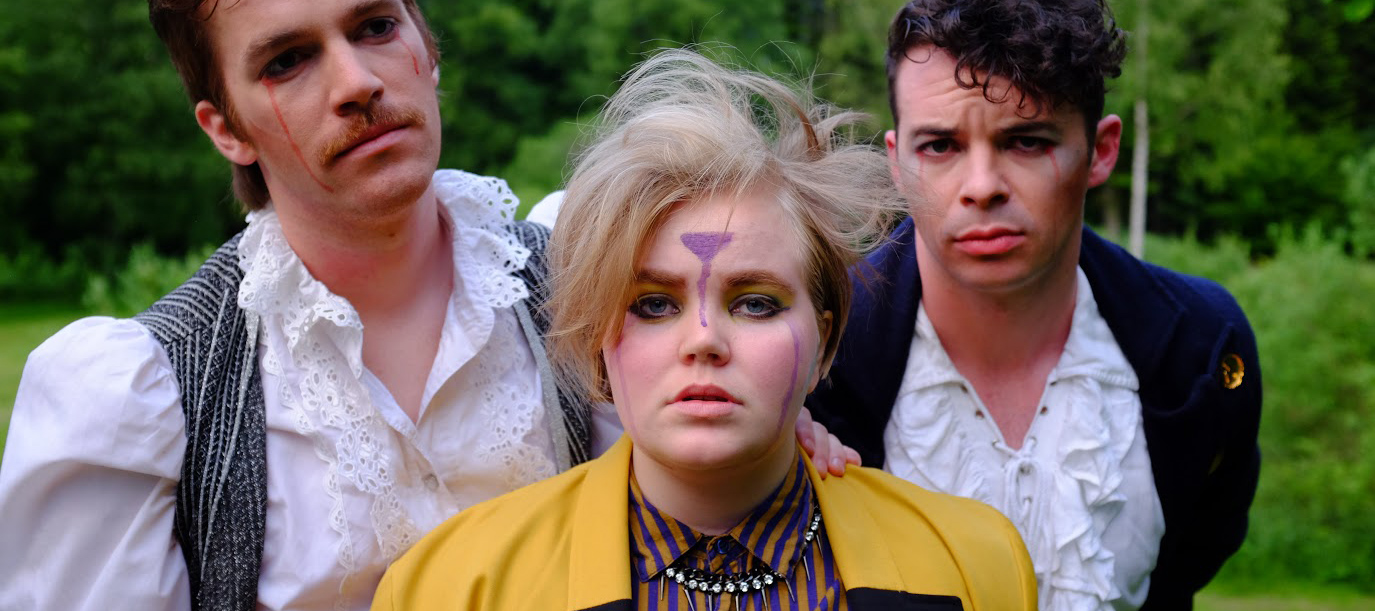
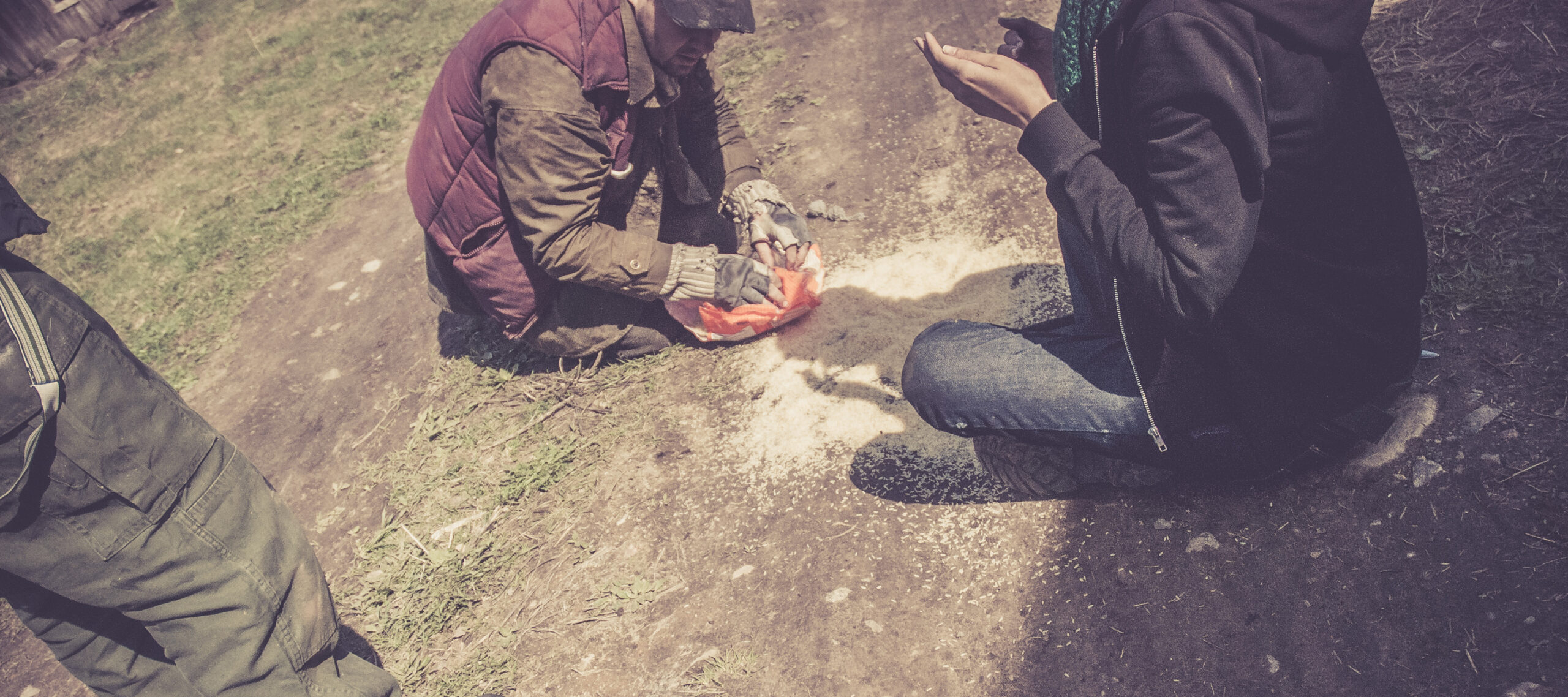







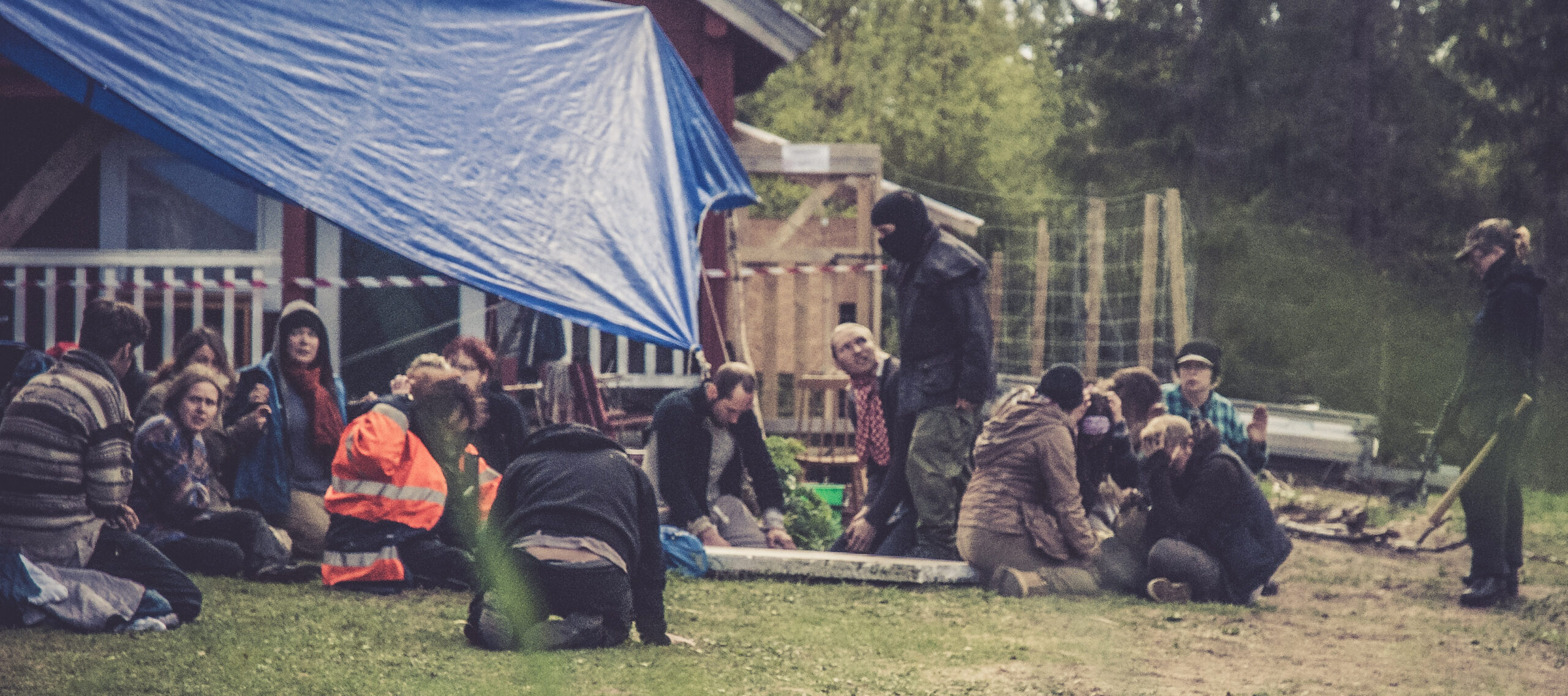




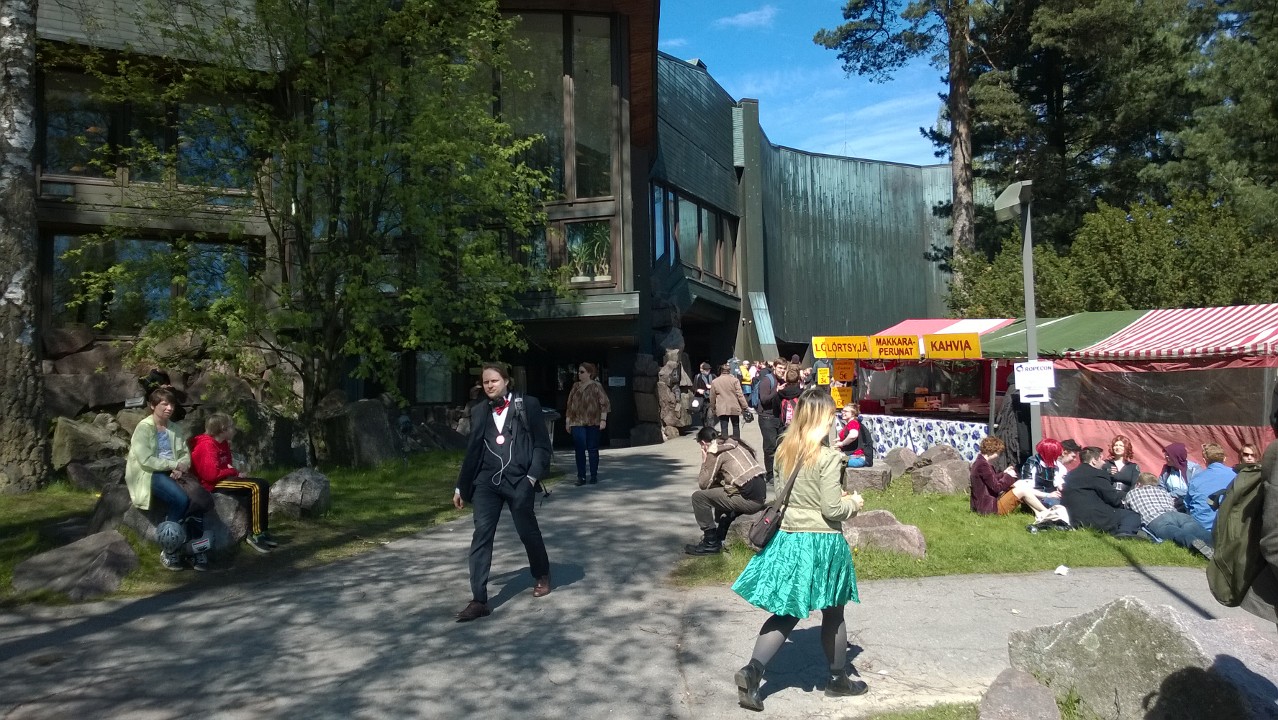
 Dipoli is a conference center in Espoo, Finland. It has been home to Ropecon from 1998, but now was the last year. Next time, it’s going to be at Messukeskus, or Helsinki Fair Centre.
Dipoli is a conference center in Espoo, Finland. It has been home to Ropecon from 1998, but now was the last year. Next time, it’s going to be at Messukeskus, or Helsinki Fair Centre.
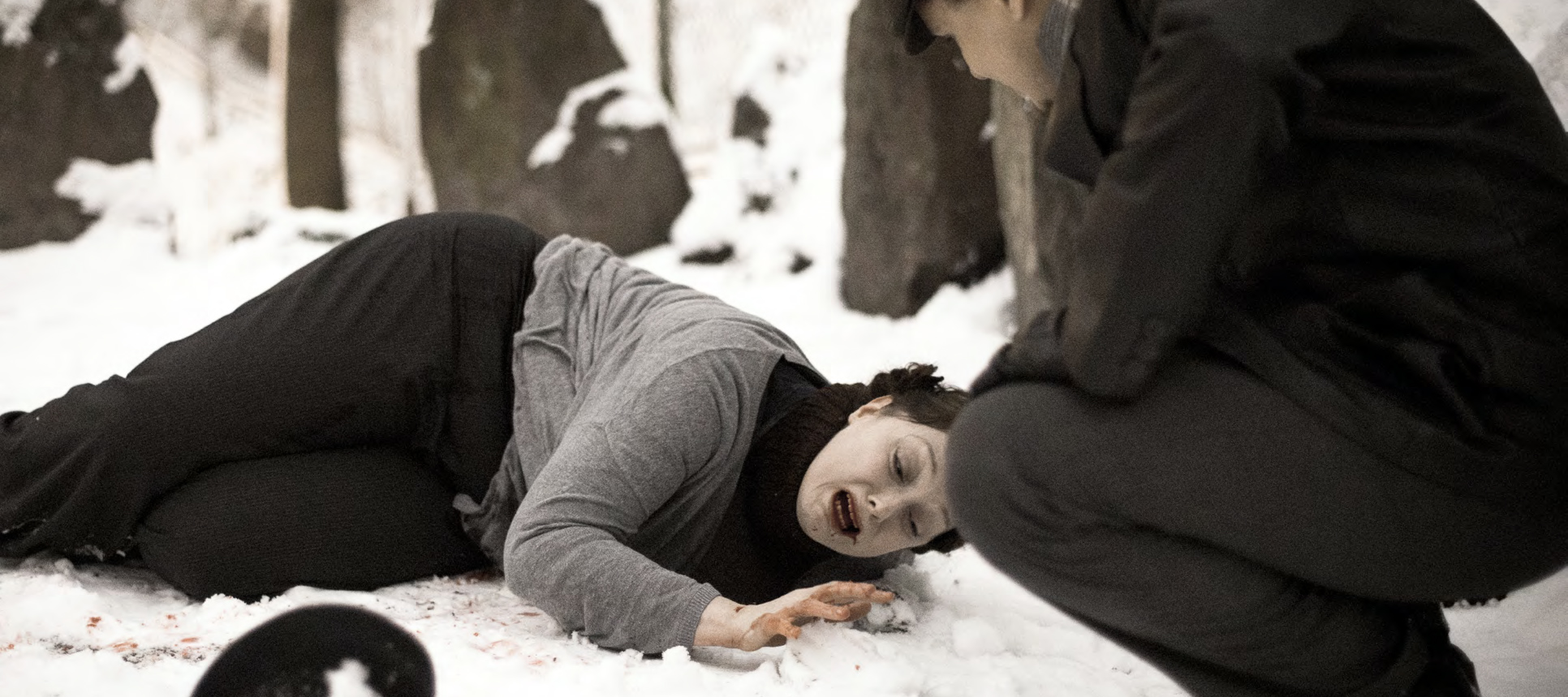



 In their written briefs before the game the players had a schedule for the game and typically from two to five different pre-planned scenes. The scenes varied significantly in duration, the amount preparations and supporting cast involved, and the degree of fateplay involved. These were designed in order to guide the storylines, dramatic structures and geographic locations of the players so that all players would have game that is meaningful, full but not too full – of action, where their wishes are fulfilled, and that would provide maximum support for character interaction and dynamics.
In their written briefs before the game the players had a schedule for the game and typically from two to five different pre-planned scenes. The scenes varied significantly in duration, the amount preparations and supporting cast involved, and the degree of fateplay involved. These were designed in order to guide the storylines, dramatic structures and geographic locations of the players so that all players would have game that is meaningful, full but not too full – of action, where their wishes are fulfilled, and that would provide maximum support for character interaction and dynamics.

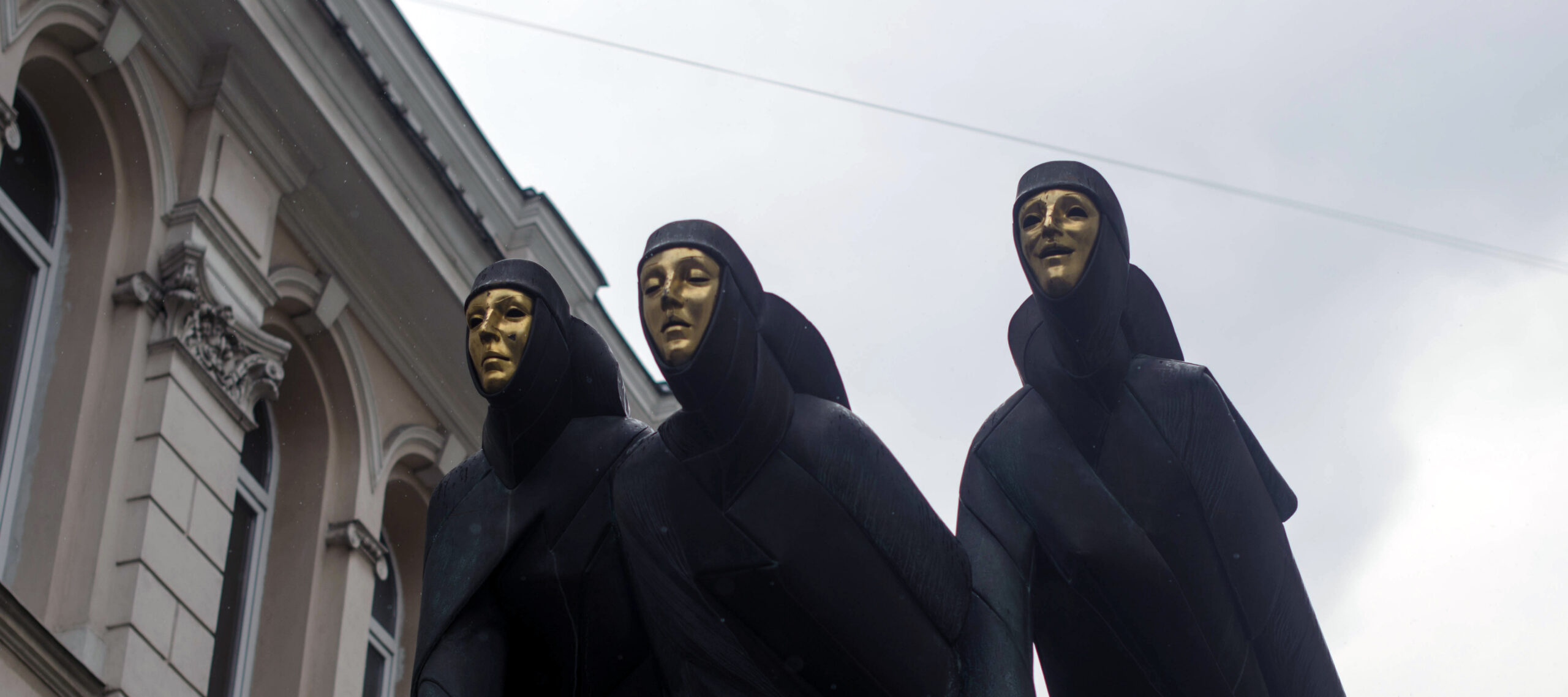
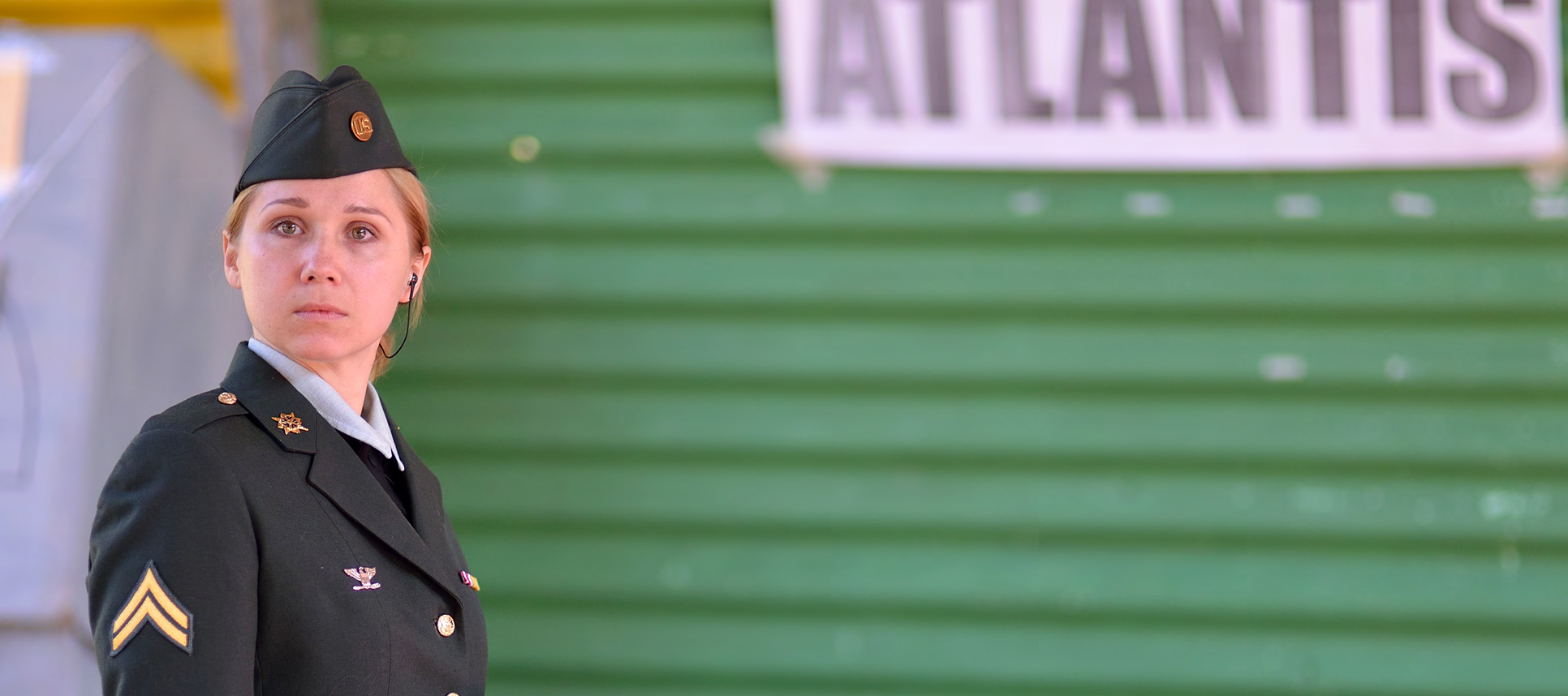
 In House portable MP3 players were used, and the participants had to switch their musical tracks manually, according to specific rules. But in the following year Moscow electronics-for-larp engineers from Ostranna CG made a step forward, so for Ticket to Atlantis we were able to use custom made electronic devices that could switch music tracks automatically, depending on where the player was and what other players were around.
In House portable MP3 players were used, and the participants had to switch their musical tracks manually, according to specific rules. But in the following year Moscow electronics-for-larp engineers from Ostranna CG made a step forward, so for Ticket to Atlantis we were able to use custom made electronic devices that could switch music tracks automatically, depending on where the player was and what other players were around. They wanted to have a lot of money – and hence the salary for one hour’s work was a thousand dollars. They had subconscious fears – and hence there was the fearful mist (represented by NPCs in silver gowns and masks, bearing smoke flares).
They wanted to have a lot of money – and hence the salary for one hour’s work was a thousand dollars. They had subconscious fears – and hence there was the fearful mist (represented by NPCs in silver gowns and masks, bearing smoke flares). All the player’s music and information on emotions was put into an electronic device we call Armlet, that players wore on their wrist. This device played music like a portable MP3 player into the participant’s ears via earphones so a player had a continuous soundtrack for their larp.
All the player’s music and information on emotions was put into an electronic device we call Armlet, that players wore on their wrist. This device played music like a portable MP3 player into the participant’s ears via earphones so a player had a continuous soundtrack for their larp. In those places there were Important Items of the characters. Having another character’s Important Item could give you enormous (and definitely not kind) power over that character, but you could bring only one object from the woods so you had to choose whether to take your own item or someone else’s.
In those places there were Important Items of the characters. Having another character’s Important Item could give you enormous (and definitely not kind) power over that character, but you could bring only one object from the woods so you had to choose whether to take your own item or someone else’s. There have been something like 5 – 10 music-based larps in Russia, the trend appeared around the beginning of 2010’s, though games besides the two mentioned above used completely different approaches to using music.
There have been something like 5 – 10 music-based larps in Russia, the trend appeared around the beginning of 2010’s, though games besides the two mentioned above used completely different approaches to using music.

 I work as a larp producer in the
I work as a larp producer in the  We had the distinct advantage of having a really cool venue, the ice breaker Suur Tõll, now a museum. It was almost too spectacular: It was easy to imagine a much bigger, much longer game taking place there.
We had the distinct advantage of having a really cool venue, the ice breaker Suur Tõll, now a museum. It was almost too spectacular: It was easy to imagine a much bigger, much longer game taking place there.
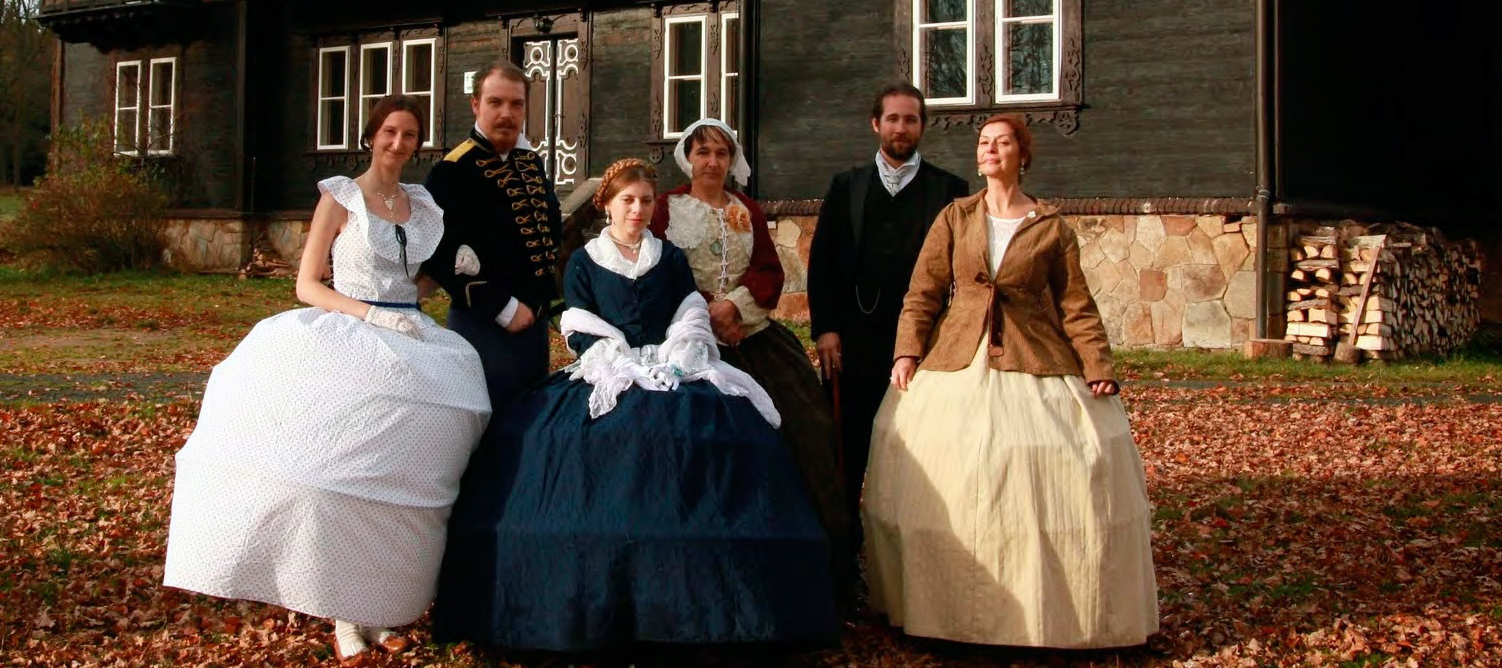
 They were designed as extra-diegetically minimalist, following the Nordic larp tradition, which stresses the overlaps of the abilities of the characters and players. The aim was to connect each background element of the setting with an opportunity to act. Cultural references weren’t just a static frame.
They were designed as extra-diegetically minimalist, following the Nordic larp tradition, which stresses the overlaps of the abilities of the characters and players. The aim was to connect each background element of the setting with an opportunity to act. Cultural references weren’t just a static frame.

